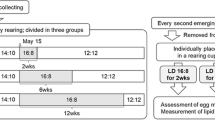Summary
The partially bivoltine, primitively eusocial sweat bee Halictus rubicundus produces two female castes, gynes and non-gynes, in its first brood in New York. Castes in this brood differentiate within the first few days of adult life, with gynes leaving the population to overwinter as early as mid-June (non-gynes further differentiate into replacement queen and worker subcastes, with older females typically dominant). Analysis of possible mechanisms of caste determination reveals that although gynes average significantly larger than non-gynes within the first brood, this appears largely due to a late mean emergence data coupled with an increase in the size of emerging females over the course of brood emergence, rather than a causal relationship. A strong correspondence between male abundance (relative to newly-emerged females) and the pattern of gyne production, along with data from dissections, suggests that females that mate when young become diapausing gynes, while those that do not mate promptly become non-gynes and do not diapause even though many mate later. Although alternatives to this simple mechanism cannot be ruled out entirely, it nevertheless offers profound implications for theoretical and empirical understanding of the evolutionary origins of the worker caste.
Similar content being viewed by others
References
Atwood CE (1933) Studies on the Apoidea of western Nova Scotia with special reference to visitors to apple bloom. Can J Res 9:443–457
Brian MV (1983) Social insects: ecology and behavioural biology. Chapman and Hall, New York, pp 240–242
Brockmann HJ (1984) The evolution of social behaviour in insects. In: Krebs JR, Davies NB (eds) Behavioural ecology: an evolutionary approach, 2nd edn. Sinauer, Massachusetts, pp 340–361
Buckle GR (1982) Differentiation of queens and nestmate interactions in newly established colonies of Lasioglossum zephyrum (Hymenoptera: Halictidae). Sociobiology 7:8–20
Bulmer MG (1983) The significance of protandry in social Hymenoptera. Am Nat 121:540–551
Eickwort GC, Kukuk PF (1987) Reproductive castes in primitively eusocial Halictid bees. In: Eder J, Rembold H (eds) Chemistry and biology of social insects. Peperny, Munich, pp 261–262
Greenberg L, Buckle GR (1981) Inhibition of worker mating by queens in a sweat bee, lasioglossum zephyrum. Insectes Soc 28:347–352
Knerer G (1980) Evolution of Halictine castes. Naturwissenschaften 67:133–135
Knerer G, Atwood CE (1966) Polymorphism in some nearctic halictine bees. Science 152:1262–1263
Knerer G, Plateaux-Quénu C (1967) Sur la production de males chez les Halictinae sociaux. Compt Rend Acad Sci (Paris) 264:1096–1099
Knerer G, Plateaux-Quénu C (1970) The life cycle and social level of Evylaeus nigripes, a Mediterranean halictine bee. Can Entomol 102:185–196
Michener CD (1974) The social behavior of the bees: A comparative approach. Harvard University Press, Cambridge, pp 95–98
Michener CD (1977) Aspects of the evolution of casters in primitively social insects. In: Proc 8th Int Cong, IUSSI, Wageningen, Netherlands, pp 2–6
Michener CD (1985), From solitary to eusocial: need there be a series of intervening species? Fortschr Zool 31:293–305
Michener CD (1989) Reproduction and caste in social halictine bees. In: Engels W (ed) Social insects: an evolutionary approach to castes and reproduction. Chapter 7, Springer, Berlin, Heidelberg New York (in press)
Michener CD, Brothers DJ (1974) Were workers of eusocial Hymenoptera initially altruistic or oppressed? Proc Natl Acad Sci (USA) 71:671–674
Michener CD, Brothers DJ, Kamm DR, (1971) Interactions in colonies of primitively social bees: artificial colonies of Lasioglossum zephyrum. Proc Natl Acad Sci (USA) 68:1242–1245
Ordway E (1966) The bionomics of Augochlorella striata and A. persimilis in eastern Kansas. J Kans Ent Soc 39:270–313
Packer L (1986) The social organisation of Halictus ligatus (Hymenoptera, Halictidae) in southern Ontario. Can J Zool 64:2317–2324
Packer L, Knerer G (1985) Social evolution and its correlates in bees of the subgenus Evylaeus (Hymenoptera, Halictidae). Behav Ecol Sociobiol 17:143–149
Plateaux-Quénu C (1960) Nouvelle preuve d'un determinisme imaginal des castes chez Halictus marginatus Brulle. Compt Rend Acad Sci (Paris) 250:4465–4466
Plateaux-Quénu C (1974) Comportement de societes orphelines D'Evylaeus calceatus (Scop.) (Hym. Halictinae). Insectes Soc 21:5–12
Poursin J-M, Plateaux-Quénu C (1982) Niches ecologiques de quelques Halictinae I. Comparaison des cycles annuels. Apidologie 13: 215–226
Sakagami SF (1977) Seasonal change of nest survival and related aspects in an aggregation of Lasioglossum duplex (Dalla Torre), a eusocial halictine bee (Hymenoptera: Halictidae). Res Popul Ecol 19:69–86
Sakagami SF, Fukuda H (1972) Life cycle of a Japanese social halictine bee, Lasioglossum duplex, out of brood rearing season (Hymenoptera, Halictidae). Insectes Soc 19:137–152
Sakagami SF, Hayashida K (1968) Bionomics and sociology of the summer matrifilial phase in the social halictine bee, Lasioglossum duplex. J Fac Sci, Hokkaido Univ (VI, Zool) 16:413–513
Saunders DS (1982) Insect clocks, 2nd edn. Pergamon Press, New York, pp 162–188
Sokal RR, Rohlf FJ (1981) Biometry 2nd edn. Freeman, San Francisco
Wheeler DE (1986) Developmental and physiological determinants of caste in social Hymenoptera: Evolutionary implications. Am Nat 128:13–34
Yanega D (1988) Social plasticity and early-diapausing females in a primitively social bee. Proc Natl Acad Sci (USA) 85:4374–4377
Author information
Authors and Affiliations
Rights and permissions
About this article
Cite this article
Yanega, D. Caste determination and differential diapause within the first brood of Halictus rubicundus in New York (Hymenoptera: Halictidae). Behav Ecol Sociobiol 24, 97–107 (1989). https://doi.org/10.1007/BF00299641
Received:
Accepted:
Issue Date:
DOI: https://doi.org/10.1007/BF00299641




